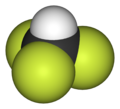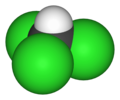Trihalomethane
Group of chemical compounds
Trihalomethanes[edit]







Trihalomethanes (THMs) are chemical compounds in which three of the four hydrogen atoms of methane (CH_) are replaced by halogen atoms. The general formula for trihalomethanes is CHX_, where X represents a halogen atom, such as fluorine, chlorine, bromine, or iodine.
Formation[edit]
Trihalomethanes are often formed as a byproduct of water chlorination, a process used to disinfect drinking water. When chlorine or other disinfectants react with natural organic matter in water, trihalomethanes can be produced. The presence of THMs in drinking water is a concern due to their potential health effects.
Health effects[edit]
Exposure to trihalomethanes has been associated with various health risks. Some studies suggest a link between long-term exposure to THMs and an increased risk of cancer, particularly bladder cancer. Additionally, there may be reproductive and developmental effects associated with THM exposure.
Regulation[edit]
Due to their potential health risks, the concentration of trihalomethanes in drinking water is regulated in many countries. For example, the United States Environmental Protection Agency (EPA) has set a maximum contaminant level for total trihalomethanes (TTHMs) in drinking water at 80 parts per billion (ppb).
Types of trihalomethanes[edit]
There are several common types of trihalomethanes, each with different halogen atoms:
- Fluoroform (CHF_)
- Chlorodifluoromethane (CHClF_)
- Chloroform (CHCl_)
- Bromodichloromethane (CHBrCl_)
- Dibromochloromethane (CHBr_Cl)
- Bromoform (CHBr_)
- Iodoform (CHI_)
Related pages[edit]
References[edit]
<references group="" responsive="1"></references>
-
Fluoroform
-
Chlorodifluoromethane
-
Chloroform
-
Bromodichloromethane
-
Dibromochloromethane
-
Bromoform
-
Iodoform
Ad. Transform your life with W8MD's Budget GLP-1 injections from $75


W8MD offers a medical weight loss program to lose weight in Philadelphia. Our physician-supervised medical weight loss provides:
- Weight loss injections in NYC (generic and brand names):
- Zepbound / Mounjaro, Wegovy / Ozempic, Saxenda
- Most insurances accepted or discounted self-pay rates. We will obtain insurance prior authorizations if needed.
- Generic GLP1 weight loss injections from $75 for the starting dose.
- Also offer prescription weight loss medications including Phentermine, Qsymia, Diethylpropion, Contrave etc.
NYC weight loss doctor appointmentsNYC weight loss doctor appointments
Start your NYC weight loss journey today at our NYC medical weight loss and Philadelphia medical weight loss clinics.
- Call 718-946-5500 to lose weight in NYC or for medical weight loss in Philadelphia 215-676-2334.
- Tags:NYC medical weight loss, Philadelphia lose weight Zepbound NYC, Budget GLP1 weight loss injections, Wegovy Philadelphia, Wegovy NYC, Philadelphia medical weight loss, Brookly weight loss and Wegovy NYC
|
WikiMD's Wellness Encyclopedia |
| Let Food Be Thy Medicine Medicine Thy Food - Hippocrates |
Medical Disclaimer: WikiMD is not a substitute for professional medical advice. The information on WikiMD is provided as an information resource only, may be incorrect, outdated or misleading, and is not to be used or relied on for any diagnostic or treatment purposes. Please consult your health care provider before making any healthcare decisions or for guidance about a specific medical condition. WikiMD expressly disclaims responsibility, and shall have no liability, for any damages, loss, injury, or liability whatsoever suffered as a result of your reliance on the information contained in this site. By visiting this site you agree to the foregoing terms and conditions, which may from time to time be changed or supplemented by WikiMD. If you do not agree to the foregoing terms and conditions, you should not enter or use this site. See full disclaimer.
Credits:Most images are courtesy of Wikimedia commons, and templates, categories Wikipedia, licensed under CC BY SA or similar.
Translate this page: - East Asian
中文,
日本,
한국어,
South Asian
हिन्दी,
தமிழ்,
తెలుగు,
Urdu,
ಕನ್ನಡ,
Southeast Asian
Indonesian,
Vietnamese,
Thai,
မြန်မာဘာသာ,
বাংলা
European
español,
Deutsch,
français,
Greek,
português do Brasil,
polski,
română,
русский,
Nederlands,
norsk,
svenska,
suomi,
Italian
Middle Eastern & African
عربى,
Turkish,
Persian,
Hebrew,
Afrikaans,
isiZulu,
Kiswahili,
Other
Bulgarian,
Hungarian,
Czech,
Swedish,
മലയാളം,
मराठी,
ਪੰਜਾਬੀ,
ગુજરાતી,
Portuguese,
Ukrainian






